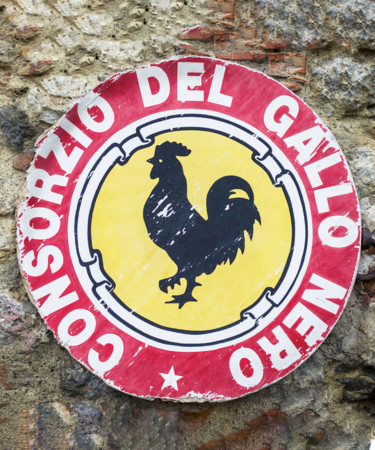Baseball has mascots, most of which make sense, some of which…well, don’t, and plenty of which that just straight-up terrify.
Wine, generally, does not have mascots. Unless you count Kathie Lee and Hoda. But there is one wine that’s had a true mascot for many, many years: Chianti Classico and its famous black rooster.
If you’re not an Italian wine lover, or leave Chianti at Silence of the Lambs references, you probably haven’t noticed the little black rooster at the top of every bottle of Chianti Classico (its position changed from a stand-alone sticker to the bottle’s tax label several years back that can be found on the neck of most bottles). But while he’s not harder to spot, he’s there, and he’s been there for years—a symbol of the Chianti region and a designated marker of specific “Chianti Classico” regulations.
And just how he got there in the first place is a pretty funny story.
But first, a bit on Chianti Classico. For total Chianti newbies, we’re not talking about the stuff you’d find in the squat, straw-covered bottles, often repurposed as candle holders, for some reason. We’re talking about a designated region (or DOCG) and classification within the world of Chianti wines. Chianti’s actually a centuries-old wine region within Tuscany, with the first written mention of Sangiovese (the predominant Chianti grape) dating as far back as 1398 (and wine production dating back maybe 2000 years). The region got appellation status in 1716 from Cosimo III de Medici—yes, those Medicis—and in 1984, Chianti Classico got its DOCG.
As with wines from other regions, like Bordeaux or Burgundy, Chianti Classicos have to meet certain standards, and can be classified differently. But for basic Chianti Classico, you need 80% Sangiovese grapes grown within the area, and 20% other selected grapes for blending. All Chianti Classicos must be at least 12% ABV (incidentally making some of them suitable for a fauxtox).
Now—the rooster. The Chianti Classico region is about 100 miles of land between Florence and Siena. The regions might be friendly enough now, but back in the day—around 800 years ago—there was a territorial feud going on between them. Each wanted a more generous border for its land. To establish official, legal borders, the two cities did what any Medieval feuding cities would do: pick a horse and a chicken and have a race.
Well, not a chicken. A rooster. As legend has it, each city would send a rider at the crack of dawn into the territory, and wherever they met up would be the boundary delineation between the cities. This being before the day of the smartphone or robotic alarm clocks you actually have to chase around, the horsemen relied on slightly more old school methods: roosters. In what seems like a huge fault in planning, the cities agreed to each select a rooster in the hopes that the bird would wake them.
Siena supposedly picked a white rooster and fattened him up, presumably assuming he’d wake up earlier for more food? Florence was a bit savvier, and crueler, selecting a black rooster and essentially starving him to encourage him to wake up earlier. Anyone who has passed out after a Thanksgiving gorge-fest (or woken up at 2am for a snack) knows, a full stomach is lazily complacent; an empty stomach tends to nudge you awake, drive you to action, and scream at you to feed it like a shrill alarm clock.
And that’s exactly what happened with the little black rooster. Hungry, and likely pretty pissed, he woke up earlier than the white rooster, cawed his vengeful caw, and the Florentine rider was off to claim a whole bunch of Chianti territory. (Distances vary, but some say the Sienese rider was less than 12 kilometeres into his ride when the Florentine met up with him and did his Medieval victory dance.) The rooster was adopted as an official emblem by the League of Chianti in 1384, and officially adopted by the Chianti Classic Wine Consortium in 2005.
And that’s why, to this day, you’ll find a proud little black rooster on a bottle of Chianti Classico. (If he’s surrounded by a red circle, it’s straight up Chianti Classico; a gold circle indicates Riserva, a slightly higher grade.)
As for the original rooster, we’re hoping he got a big heaping handful of corn as a reward.
